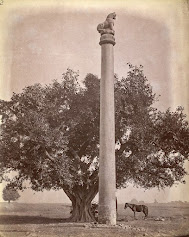Introduction
India, a land of diverse landscapes and vibrant colors, has a history as ancient as time itself. From the majestic Himalayas to the sun-kissed beaches of its southern coastline, this vast nation has been a melting pot of civilizations, cultures, and traditions for thousands of years. The history of India is a tapestry woven with countless threads, reflecting the resilience, creativity, and enduring spirit of its people. As we embark on this fascinating journey, let us delve into the kaleidoscope of India's past and discover the vibrant cultural heritage that has shaped the nation we know today.
 |
| Ancient India |
Ancient India: Cradle of Civilization
Ancient India, with its Indus Valley Civilization, stands as one of the cradles of civilization. Dating back to around 2500 BCE, this remarkable civilization flourished along the Indus River. Known for its advanced urban planning, sophisticated craftsmanship, and thriving trade, the Indus Valley Civilization left a significant impact on human history. Archaeological sites such as Harappa and Mohenjo-Daro reveal their well-structured cities, intricate seals, and sculptures, showcasing their engineering skills and artistic prowess. The civilization's standardized system of weights and measures and engagement in trade highlight their economic acumen. The Indus Valley Civilization serves as a testament to the ingenuity and cultural richness of ancient India, leaving a lasting legacy that shaped subsequent civilizations in the region.
The Vedic Period and the Rise of Kingdoms
Around 1500 BCE, Indo-Aryan tribes migrated into the Indian subcontinent, bringing with them the Sanskrit language and Vedic traditions. The Vedic period witnessed the composition of the sacred texts known as the Vedas, which formed the foundation of Hinduism, one of the world's oldest religions. This era also witnessed the rise of mighty kingdoms, such as the Mauryas, Guptas, and Cholas, who left an indelible mark on India's political landscape and cultural development.
 |
| The Pillars of Ashoka |
Golden Age of Indian Empires
The classical period of Indian history saw the emergence of powerful empires, each contributing to the country's rich heritage. The Mauryan Empire, under the visionary rule of Emperor Ashoka, embraced Buddhism and propagated its principles of non-violence and tolerance throughout the land. The Gupta Empire, often referred to as the "Golden Age" of India, witnessed remarkable achievements in the fields of mathematics, science, art, and literature, leaving an indelible legacy that influenced subsequent generations.
Cultural Crossroads: Invaders, Traders, and Synthesis
India has long been a crossroads of cultures, attracting invaders and traders from different parts of the world. Throughout history, India witnessed the influx of Persians, Greeks, Turks, and Mughals, among others, each leaving their imprints on the Indian cultural landscape. This cultural fusion resulted in a remarkable synthesis of traditions, religions, and artistic styles. The architectural marvels of the Mughals, such as the iconic Taj Mahal and the majestic Red Fort, exemplify the harmonious blend of Indian and Islamic aesthetics.
Colonial Rule and Struggle for Independence
The arrival of European powers, most notably the British, marked a significant turning point in Indian history. The British East India Company gradually established its dominance, exploiting India's resources and imposing oppressive policies. However, this period also witnessed the birth of a fierce resistance movement against colonial rule. Led by stalwarts such as Mahatma Gandhi, Jawaharlal Nehru, and Subhas Chandra Bose, the struggle for independence gained momentum, ultimately culminating in India's liberation in 1947.
Unity in Diversity: India Today
Present-day India stands as a vibrant and diverse nation, proudly embracing its rich cultural tapestry and varied heritage. The traditions, festivals, art forms, and languages that have evolved over centuries continue to thrive, weaving together a social fabric that is both vibrant and harmonious. From the classical dances of Bharatanatyam and Kathak to the spiritual practices of yoga and meditation, India's cultural contributions resonate far beyond its borders, captivating and inspiring people from all walks of life.
Conclusion
The history of India is an enchanting saga of resilience, innovation, and synthesis. From the ancient Indus Valley Civilization to the struggles for independence and the mosaic of cultural diversity that exists today, India has weathered the storms of time while retaining its distinct identity. As we immerse ourselves in its rich heritage, we discover that India is not just a nation but a celebration of life, a testimony to the endurance of the human spirit, and a living embodiment of unity in diversity. The threads of its history and the vibrant colors of its cultural heritage continue to shape India's journey, ensuring that its past remains inseparable from its present and future.
Follow for more : https://youtu.be/17xCC1eMNdwhttps://youtu.be/17xCC1eMNdw

.jpeg)











0 Comments